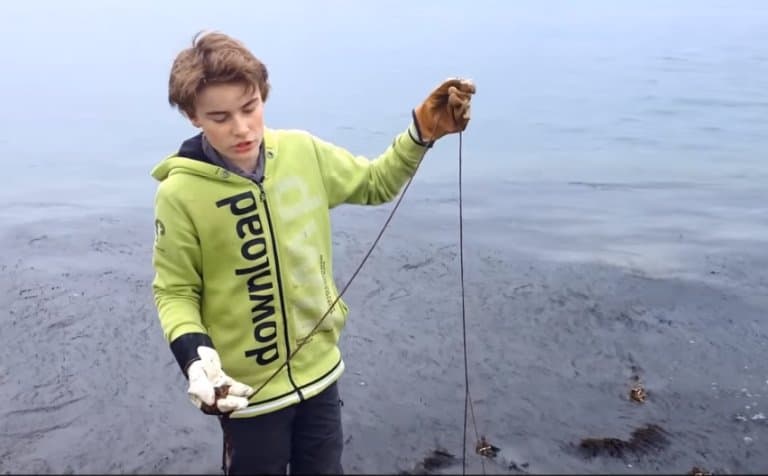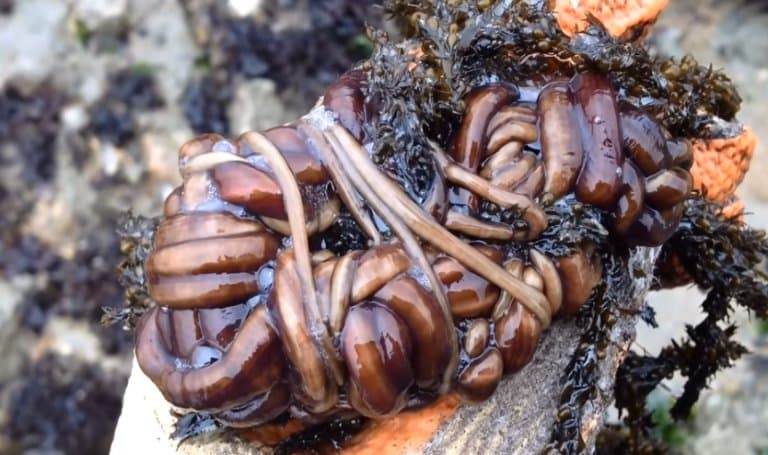Bootlace Worm Profile
Worms are well known for being the most docile and polite creatures on Earth. But there are hundreds of billions of worms for every human on the planet, and they’re not all gentle.
Many are microscopic parasites, and at least one is possibly the longest animal on earth: a toxic predator called the bootlace worm.

Bootlace Worm Facts Overview
| Habitat: | Colder, temperate waters |
| Location: | Northern Europe, Baltic areas |
| Lifespan: | Unknown |
| Size: | At least 30 m (100 ft), maybe up to 55 m (189 ft) |
| Weight: | Unrecorded |
| Color: | Orange-red with a white belly |
| Diet: | Smaller invertebrates, fishes |
| Predators: | Possibly crustaceans |
| Top Speed: | Slow |
| No. of Species: |
1 |
| Conservation Status: |
Not Listed (IUCN) |
Bootlace worms are long. Nobody knows for sure how long, on account of them coiling up like a tangled set of earphones and being exceedingly stretchy when laid out on the beach. However, they’re certainly one of the longest animals on earth and come with some scary poison too.
These ocean predators float about in the water column and scan the sea bed for prey in the temperate waters of Northern Europe, often surprising divers with their ability to collapse in on themselves.
But it’s their toxic mucous that makes them a potential wonder animal.
It contains an effective pesticide that may be useful in fighting colony collapse disorder in bees and fighting off common crop pests on farms and in gardens.
Interesting Bootlace Worm Facts
1. This one’s not named after Linnaeus
This might come as a surprise to anyone familiar with the taxonomist, as Carl Linnaeus was responsible for naming over 12,000 animals and plants and devising the naming system that we still use today.
But this worm, Lineus longissimus is likely named after something far less famous; either after linen or “a line”, in reference to its length.
2. They’re really long! (But they lack girth)
The basis for the maximum length of this worm is taken from a measurement by a Scottish marine zoologist in 1864. A particularly lengthy individual washed up on a beach after a storm and was laid out straight for measuring.
The worm was recorded at a phenomenal 55 meters long, which would make it the longest animal on Earth.
Despite this extreme length, the body of the animal is usually no more than 5 or 10 millimetres across, making it also one of, if not the most lanky animals in the world.
But this may not be what it seems. 1

3. They’re probably not as long as they say they are
Reports of length are often exaggerated for bragging rights and are dependent on how much stretching is involved during the measurement. And bootlace worms are certainly stretchy.
Bootlace worms are quite rubbery, meaning that museum samples can be artificially elongated for effect.
This puts the record length of 55 meters into question and is yet to be truly confirmed, however, divers routinely witness 30-meter specimens, and 5-10 meter individuals are very common.
In fact, in at least one body of water in Ireland, they were found to be the most common species of Nemerteans. 2
4. They’re predators
You’d think something as scrawny as a bootlace would be some kind of bacteriophage or parasite, but this exceptionally skinny animal is a frightening predator. They patrol the sandy beds, weaving in and out of rock crevices hunting for anything small enough to kill and eat.
Once they find a victim, they puff out a proboscis full of toxins to paralyse it.
But they’re not above scavenging either, they’ll happily eat dead worms and other invertebrates they come across, and they do this by swallowing them whole, head first, just like a snake.
5. They’re retractable
Not only is this proboscis retractable, but the whole worm is also. They’re extremely elastic, which is why an accurate account of their real length is hard to come by. When touched by divers, they quickly shrink in size by several meters, and try to disappear into a crack in a rock.
This outstanding ability to change in length is due to their hydrostatic skeleton. A huge range of animals makes use of this form of structural support. Having no bones, worms instead use pressurised fluid, held in place and manipulated using a series of muscular contractions.
This internal pressure allows the animal to move the fluid to where it needs to be, everting a proboscis, for example, or contracting its length. Even insects with hard exoskeletons make use of these systems when moulting, and when puffing out their wings. 3
6. They’re very toxic
Having no hard protection against enemies, the bootlace worm has developed a toxin-based defence. When handled, it’ll release copious amounts of mucous, containing some incredible peptides that have the power to paralyse and affect the nerves.
Some of these toxins are very similar to the infamous puffer fish toxin, tetrodotoxin, and are produced by the bacteria that live on the worm. The mechanism isn’t fully understood, but this may be a form of symbiotic relationship between the bacteria and the worm. 4
7. They’re the most poisonous animal in Sweden!
Okay, this might be a bit like saying they’re the slimmest person in KFC, but since it was a Swedish team who discovered this toxin, they get to make that claim.
These toxins are being isolated and investigated for their mechanism of action by the Swedish researchers who are studying them and are found to be particularly potent. They’ve been shown to block sodium channels in the nerves of several common invertebrates.

8. This might be useful to gardeners
These toxins are still under-researched, but could be a promising avenue of exploration for a multitude of pesticide applications.
The German cockroach, the fruit fly, and the notorious Varroa mite, a killer of bees, have all been tested with these toxins and have died spectacularly. This could be great news for agriculturalists looking for a biopesticide that (hopefully) doesn’t cause too much collateral damage. 5
Bootlace Worm Fact-File Summary
Scientific Classification
| Kingdom: | Animalia |
| Phylum: | Nemertea |
| Class: | Anopla |
| Order: | Heteronemertia |
| Family: | Lineidae |
| Family: | Lineus |
| Family: | Lineus Longissimus |
Fact Sources & References
- Adriaan Gittenberger & Cor Schipper, “Long live Linnaeus, Lineus longissimus (Gunnerus, 1770) (Vermes: Nemertea: Anopla: Heteronemertea: Lineidae), the longest animal worldwide and its relatives occurring in The Netherlands”, Naturalis.nl.
- Cynthia D. Trowbridge (2015), “Nemerteans in an Irish marine reserve: synopsis of current and historical records”, Sci-Hub.
- William M. Kier (2012), “The diversity of hydrostatic skeletons”, The Company of Biologists.
- Andersson (2015), “Discovery of peptide toxins in the world’s longest animal (The bootlace worm; Lineus longissimus): challenging claims of tetrodotoxin production”, Aalborg Universitet.
- Jack Bell (2021), “The insecticidal activity of recombinant nemertide toxin α-1 from Lineus longissimus towards pests and beneficial species”, Science Direct.
